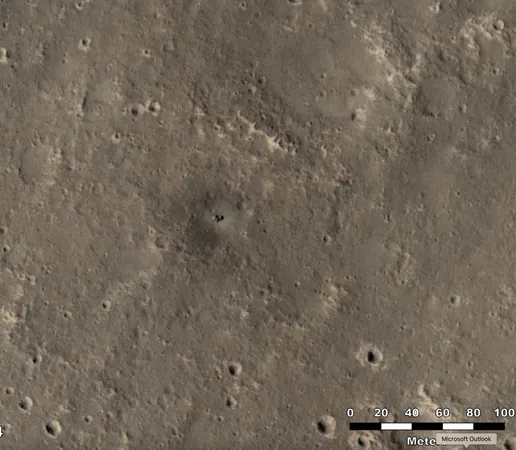
NASA's Mars Orbiter Captures Stunning Images of InSight Lander's Dust Accumulation
2024-12-16
Author: Jacob
NASA's Mars Orbiter Captures Stunning Images of InSight Lander's Dust Accumulation
Newly released images from NASA's Mars Reconnaissance Orbiter (MRO) unveil the stunning transformation of the InSight lander, which has been retired since December 2022. Captured using the orbiter's High-Resolution Imaging Science Experiment (HiRISE) camera on October 23, these pictures highlight the significant amount of dust accumulating on InSight's solar panels, giving them a reddish-brown color that mirrors the Martian surface.
InSight, which landed on Mars in November 2018, pioneered the field of seismology on the Red Planet by recording marsquakes that revealed insights into Mars' internal structure, including details about its crust, mantle, and core. Over its productive mission, the areal coverage of dust on InSight's solar panels became a point of concern for NASA engineers, as the accumulation impacted the lander’s ability to generate sufficient solar power.
Despite its retirement and loss of communication with Earth, engineers remained hopeful that Martian winds could clear the dust, allowing the lander's batteries to recharge. Unfortunately, after nearly two years of silence, NASA will officially cease listening for signals from InSight at the close of this year.
The recent HiRISE image serves not only as a final farewell to the beloved lander, but also as a valuable record of the evolving Martian environment. "Even though we’re no longer hearing from InSight, it’s still teaching us about Mars," noted Ingrid Daubar from Brown University. Monitoring the accumulation and dispersal of dust provides essential data that enhance understanding of the Martian wind and dust cycle—key factors in unraveling the planet's climatic conditions and environmental changes.
The Role of Dust on Mars
Dust is a dominant force on Mars, greatly influencing both atmospheric dynamics and surface morphology. By studying dust patterns, scientists can glean insights into preparing for future missions, especially those dependent on solar power, as dust contamination can hinder mechanical operations.
During its operational phase, InSight's sensors and MRO imagery facilitated extensive research on dust devils—temporary whirlwinds that sweep across the Martian terrain. Notably, scientists found that activity from these dust devils peaks during the Martian summer and wanes in winter.
Crater studies are another important aspect of Martian research linked to InSight's findings. The density of craters helps establish the relative age of different regions; more craters indicate an older surface, crucial for understanding Mars' geological history. Scientists also examined InSight’s landing marks, which are gradually blending back into the surrounding landscape—a vivid example of dust’s persistent effect on the Martian surface.
HiRISE has been instrumental in capturing images from various Mars missions, including the active Perseverance and Curiosity rovers. Together, these missions contribute to a comprehensive understanding of Mars, including surface processes and potential for future exploration.
Daubar expressed a bittersweet sentiment, saying, "It feels a little bittersweet to look at InSight now. It was a successful mission that produced lots of great science, and while we wish it could last forever, we appreciate the contributions it made."
Looking Ahead
Looking forward, the knowledge gained from InSight continues to inform Mars exploration strategies. As engineers and scientists build on the legacy of this mission, they prepare for future endeavors that may include setting up human missions on Mars or exploring other celestial bodies. As they do, they’ll carry forward the invaluable lessons learned about dust's role in shaping not only Mars but our understanding of planetary processes.
Stay tuned for more exciting updates from Mars as exploration continues to unveil the mysteries of our neighboring planet!









 Brasil (PT)
Brasil (PT)
 Canada (EN)
Canada (EN)
 Chile (ES)
Chile (ES)
 España (ES)
España (ES)
 France (FR)
France (FR)
 Hong Kong (EN)
Hong Kong (EN)
 Italia (IT)
Italia (IT)
 日本 (JA)
日本 (JA)
 Magyarország (HU)
Magyarország (HU)
 Norge (NO)
Norge (NO)
 Polska (PL)
Polska (PL)
 Schweiz (DE)
Schweiz (DE)
 Singapore (EN)
Singapore (EN)
 Sverige (SV)
Sverige (SV)
 Suomi (FI)
Suomi (FI)
 Türkiye (TR)
Türkiye (TR)